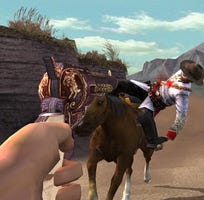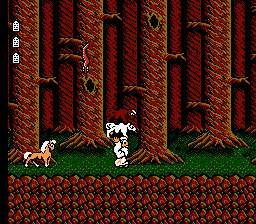Trending
Opinion: How will Project 2025 impact game developers?
The Heritage Foundation's manifesto for the possible next administration could do great harm to many, including large portions of the game development community.
In his latest 'Designer's Notebook' column, veteran designer and educator Ernest Adams suggested that the game industry has "matured into a form that has left the concept of genre in something of a muddle", and analyzes the resulting melange in depth.

I think the game industry has finally matured. But it has matured into a form that has left the concept of genre in something of a muddle, and in this column I'm going to try to sort it out.
During the early 1980s, the game industry experienced an explosion of creativity. There were games about all kinds of weird things. Anybody could make a game for the Atari 2600, so a lot of people did -- some great, some awful. Ditto the Commodore 64, the Atari ST, the Amiga, and eventually the IBM PC.
It was an era when a game that sold 250,000 units was a smash-hit, and a map-based game about geopolitics with no animation whatsoever (Balance of Power) could find a publisher.
At this point the game genres were not hard and fast. Developers could try anything, and if it sold, it was good. The console industry crashed in 1983 due to a glut of shoddy products in the marketplace. When Nintendo rebooted the console game industry in 1985, it did so in a form that shut out the little guy.
To build a Nintendo game, you had to have a Nintendo developers' license, and they wouldn't give one to just anybody. All the other console manufacturers followed suit.
Over the years the big money moved in. As games became more popular, they also cost more and more to build. There was no indie movement to speak of. Only large publishers had a chance of making it onto the store shelves, and the large publishers were increasingly conservative.
During this period, games settled into a neat set of genres that everybody recognized: sports, strategy, racing, fighting, action, role-playing, and so on. The retailers began organizing their shelves along these lines. Publishers created product plans based on them. Gamers learned to prefer one genre over another, and to identify themselves as fans of shooters or platformers or real-time strategy.
Unfortunately, anything that didn't fit didn't stand a chance. I, and a lot of colleagues who think the way I do, spent most of the 1990s demanding, "Is this really all we can do?" Video games had gone from being a kiddie medium to a hardcore gamers' medium, but they were dominated by a few big publishers and they were stuck in a rut. We weren't reaching a truly mass market, we weren't serving the niches, and we weren't innovating creatively.
Then came internet distribution, Flash games, the casual market, free game-building tools and perhaps most importantly, the Independent Games Festival to give it all a focus. ZOMGWTF!
The explosion we're experiencing now makes the first one look like a damp firecracker. It's great. We've got stuff like Blueberry Garden and Everyday Shooter and Passage and Darwinia. All these games are living happily alongside Mass Effect and Grand Theft Auto and Pro Evolution Soccer.
Of course, they don't make as much money, but that's OK -- they don't have to. The business is no longer a zero-sum game limited by available space on the retail store shelves.
That's what I mean by saying that it has matured: we have big companies making blockbusters and indie developers making indie games and artists making arty games and goodness knows what all else. And I'll never moan, "Is this all we can do?" again.
But it does mean that our nice neat collection of genres has turned into a serious muddle. Where in the world do you put something like Blueberry Garden or Passage?
And that's not all; the use of games for other purposes is creating confusion too. Recently someone asked me, "Where do we put Christian games? And what's the story with serious games? And games for girls?"
You can slice up the universe of interactive media along many different dimensions, and genre is only one of them. But in order to be able to talk about it sensibly, we have to define what these dimensions are.
Fiction book genres are based on subject matter and to some extent, emotional tone. There are techno-thrillers, westerns, romance novels, mysteries, spy novels, historical fiction, and so on. The book's setting plays a role in defining its genre.
Film is much the same, except that far more films than books are comedies, and just about any other genre of film can be made into a comedy: Blazing Saddles and Rustler's Rhapsody were western comedies, for example.
Video games work differently, as we know, and so far as familiar cases are concerned, it's easy to see. Video game genres are determined by gameplay: what challenges face the player and what actions he takes to overcome those challenges. So we clearly have sports games, shooter games, racing games, and so on.
Genres actually exist in a hierarchy. The Entertainment Software Association's 2009 Essential Facts About the Computer and Video Game Industry explicitly identifies (using data from the NPD consumer research firm) a number of what they call super-genres.
For example, sports games can obviously be further subdivided by sport, and racing games by type of vehicle. Tactical shooters emphasize real weapons and quantities of ammunition, while games like Quake, which is mostly about speed, do not.
Genres themselves are fluid. More and more games are hybrids of the traditional genres: modern role-playing games often incorporate physical coordination challenges more typical of fighting games, and action-adventures are now more popular than either the pure platformers or the pure adventure games they borrow from.
And in the current explosion of creativity, it may be difficult to assign a game to a familiar genre, as with Passage. But that's all right. It's still the case that gameplay (which determines genre) is a separate dimension from the other dimensions that define a game. I'll look at them next.

A game's setting is independent of its genre, which I think confuses people who are more familiar with books and movies. Westerns and science fiction books are in different parts of the bookstore, but that's not true of games.
A shooter is a shooter, whether it's set in the Old West or on Mars or anyplace else. A player who enjoys shooters will probably enjoy one no matter where it's set, if it's well-made.
Likewise, you can have completely different genres in the same setting. Both Gun (a shooter with RPG elements) and Oregon Trail II (a management game with a hunting mini-game inside) are set in variants of the Old West.
So far, so familiar. Now let's turn to this business of who the game is intended for: the audience. This is, again, a different dimension from genre. We have driving games aimed at aficionados, and driving games aimed at casual players. Both offer the same challenges and the same controls -- steering, acceleration, and brakes.
But the games for gearheads will probably look different from those for casual players, and the games for casual players will probably be more forgiving, allowing the player to recover easily from crashes, for example.
In particular "games for girls" are not a genre -- as my friend Sheri Graner Ray has been saying for many years. Girls are an audience, a market, not a genre. Consequently, "games for girls" is a marketing term. It has nothing to do with gameplay.
The kinds of games marketed under the "for girls" label have all sorts of gameplay. Ubisoft's Imagine games are about everything from figure skating to veterinary care.
If you need any more persuading that audience is unrelated to genre, just turn it around and think about the idea of "games for boys." Does that tell you anything at all about the game? Only that it probably isn't sold in a pink box. Boys are no more a genre than girls or women are.
In literature, the theme is the message or lesson of the work. Many games don't have an explicit theme, but they certainly can. For example, Peacemaker is a game of diplomacy and politics whose goal is to achieve a peaceful two-state solution in Palestine.
Its message is made pretty clear by its explicit victory condition, and further emphasized by its mechanics: if you play the game as a hawk, you will lose in short order. (If you play it as a bleeding-heart dove, you'll also lose, but it will take longer.)
Some critics complained that The Sims promoted typical Western notions of capitalist consumerism: its theme was "material goods make you happy." What they failed to recognize was that The Sims (at least the first edition) was actually a satire of this idea, as you can tell by reading the tongue-in-cheek descriptions of the furniture for sale. And indeed material goods alone do not make the sims happy; they need also need social interaction, fun, and other, non-material, things to be happy.
 Theme, therefore, is the characteristic that sets Christian games apart from others, and again it is a different dimension from genre. Catechumen is, bizarrely, a shooter -- although what the player shoots is not bullets but spiritual rays, and the effect they have is not death but to convert the target to Christianity (if the target is a Roman soldier; if he's a demon, he is dispatched to Hell).
Theme, therefore, is the characteristic that sets Christian games apart from others, and again it is a different dimension from genre. Catechumen is, bizarrely, a shooter -- although what the player shoots is not bullets but spiritual rays, and the effect they have is not death but to convert the target to Christianity (if the target is a Roman soldier; if he's a demon, he is dispatched to Hell).
Guitar Praise, on the other hand, is a Christian-themed rhythm game obviously modeled on Guitar Hero. Bible Adventures was a classic side-scroller in the NES and Genesis era. Different genres, different settings, same theme.
Christianity struggled against hostile forces in its early years; so too did Islam. Mohammed's wars with the Meccan tribes would make a great game were it not for the strict prohibition against depictions of the Prophet. But it might be possible to design a different Islamic-themed game -- about the challenges faced by a poor person making the hajj, perhaps.
I've decided to call the last dimension that I'm going to address in this column purpose. This refers to the reason the developers made the game in the first place, and what they hope to achieve with it. Purpose is just as independent of genre as theme, setting, or audience are.
One purpose is entertainment. Entertainment games are generally made for one or two reasons: to entertain the player and (in most cases) to make money.
Some (actually, a surprising number of) noble-spirited souls make games for entertainment without any hope of gain at all. A few misguided creatures also make games purely for money without regard for whether it entertains the player or not -- this purpose produces shovelware.
Serious games are, in Ben Sawyer's useful formulation, games to solve problems. This doesn't preclude entertainment; solving problems is simply an additional purpose of the game. There are many subcategories of serious game: games for education, healthcare, advertising, political propaganda, evangelism, and so on.
(A Christian-themed game that tries to persuade players to become Christians is also a serious game; but most Christian-themes games are entertainment for players who are already Christians.)
The designers of serious games occasionally have to compromise the quality of their entertainment in order to achieve their serious aim. For example, truly hardcore war games, as played by the military, aren't necessarily fun. But the better serious video games manage to accomplish their serious goal -- training, investigation, advertising, etc. -- and to be enjoyable as well.
 Then there are games as works of art. Because art expresses the vision of an artist, a "game" (and yet again we see the limitations of that word) designed to be a work of art may, like a serious game, compromise entertainment for another goal.
Then there are games as works of art. Because art expresses the vision of an artist, a "game" (and yet again we see the limitations of that word) designed to be a work of art may, like a serious game, compromise entertainment for another goal.
Any video game must strike a balance between the designer's vision and the players' desires (see my column, "The Tao of Game Design" for more on that), and in my opinion any commercial designer needs to put the player first and himself second.
But art games, I recognize, are different. Again, it's a continuum, and the individual designer must choose for himself where he wants his game to fall along it.
These aren't the only purposes for which games can be made; they're just a few major ones. Super Columbine Massacre RPG is a satire; I don't know if it qualifies as an art game or not, but it obviously wasn't intended to make money or solve a problem, and perhaps not even to entertain. Satire may be another purpose in its own right.
So there you have a few of the myriad dimensions along which games may be measured: genre, setting, audience, theme, and purpose. I've chosen to address only those because those are the ones that resolve the problem of how to discuss games with Old West or contemporary urban settings, games for girls, Christian games, and serious games.
What's my authority for making all these pronouncements? Nothing, really, apart from common sense and 20 years of observation. If you're an old-timer like me, this all may seem obvious. But clearly it isn't, if some people are still struggling to understand it. I hope I've helped a little.
Read more about:
FeaturesYou May Also Like